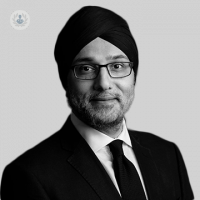Visualase® life-saving new treatment inoperable brain tumours
Autore:“You have a brain tumour” is a phrase you never expect to hear. To make matters worse, imagine being told that not only do you have a brain tumour but it’s developed in an area of the brain that cannot be operated on. This happens to hundreds of patients every year; surgery is denied because of the damage it can cause to surrounding healthy tissue in the brain.
Fortunately, there is now a lifeline for patients in the form of a new precision laser beam called the Visualase® procedure. Mr Ranjeev Bhangoo and Professor Ashkan, neurosurgeons at The London Neurosurgery Partnership, are currently the only two surgeons in the UK able to perform this procedure. Mr Bhangoo explains exactly how it works and how more advanced it is compared to other treatments available.

Is brain cancer common?
Brain Tumour Research states that around 16,000 adults are diagnosed with brain cancer every year in the UK, and it continues to kill more children and adults under the age of 40 than any other cancer.
There is a form of cancerous brain tumour called glioblastomas, which is luckily relatively rare but extremely aggressive with a poor survival rate at 14-15 months after diagnosis. Around three out of 100,000 adults develop this type of cancer every year and makes up around 50% of all brain tumours. It is currently a crucial public health issue as so many of these patients are denied surgery because of the risks involved. Fortunately, there is now a new lifeline for these patients in the form of a new precision laser beam that heats and destroys previously inoperable brain tumours. This procedure is known as Visualase®.
What is Visualase®?
Visualase® is a minimally invasive procedure and involves making a very small incision, just one centimetre long. The doctors are able to use real-time MRI-guidance while inserting a narrow tube into the tumour and beaming a laser down and into the tumour. This laser then heats up to about 70°C to destroy the cancerous cells, all the while avoiding damage to the surrounding brain tissue.
These types of procedures are generally associated with quicker recovery times and reduced risk of infection.
The term ablation refers to the destruction of the tumour by using heat. We’ve found that this technique can also be used in treating epilepsy. The same process is used to ablate the brain tissue which is causing the epileptic seizures. This procedure provides epileptic patients with an immediate treatment option instead of traditional medication or invasive surgery.
How effective is the procedure?
The system was approved back in 2010 by the FDA. As it’s a new form of technology, the long-term outcomes aren’t entirely known but findings indicate that most patients experience immediate improvement and the results have lasted months to years. Studies are still ongoing.
Pablo Casasbuenas was a patient that Professor Askan, my colleague at the London Neurosurgery Partnership and I treated. He had an aggressive and deep-seated tumour and was told he only had one year to live. He agreed to undergo this treatment after previous treatments such as radiotherapy, chemotherapy and craniotomy failed to treat the tumour and it kept growing. Following the Visualase® procedure, Mr Casasbuenas said that he “woke from surgery feeling pretty good, with just a tiny plaster on my head instead of bandages and stitches as before”.
In regards to the recovery, he stated that the next day he simply “went home with paracetamol but didn’t really need it”, and after seven days he was “back to running, and three weeks later (he) competed in a duathlon”. Pablo now says he is “living life again” and to be given this chance makes him feel “truly blessed”.
Mr Ranjeev Bhangoo is a neurosurgeon based in London. To make an appointment with him, visit his Top Doctors profile and book online.


